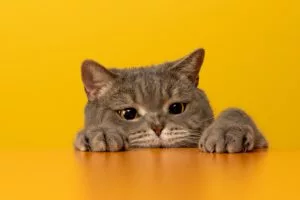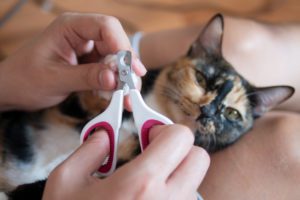If you have a cat, you probably know that they sometimes use their claws to express themselves. This can mean that they will claw things like your furniture and your rugs just because it is part of their instinctual desires to do so. This can be one of the most frustrating parts of cat ownership and many people will complain about this one part of cat ownership even if they love their cats.
Some people will elect to have their cat declawed to help deal with this tough behavior. This can seem like an ideal situation from the outside looking in. This seems like it would offer you a cat that cannot damage things all due to a simple procedure. This masks some of the less desirable parts of this surgical process for most cats, however.
If you want to learn more about the downsides of declawing your cat, you need to read on!

What is Cat Declawing?
Cat Declawing is a surgical procedure that is done by amputating the last digit of your cat’s toes. The claw attaches here, and it is removed with a scalpel or a guillotine clipper during surgery.
There is yet another way to complete this surgery and this method uses a surgical cut, to cut the tendon that allows your cat to extend their claws. This last option can lead to major health issues with claws that grow into the foot pads or grow incorrectly and extend into areas of the foot that should not have claws in them.
Some people will elect to just declaw the front paws of their pet while other people will elect to have this surgery done to all 4 feet. This is a surgery that is just like cutting off the last digit off every finger of a human hand.
What Is the Downside to Cat Declawing?
The biggest argument against this procedure is easily understood if you consider what the surgery actually consists of. This surgery is an amputation of a healthy bone on every toe of a cat’s feet. This is a painful surgery that causes lasting health issues for many animals that are subjected to it.
Common problems after a declawing surgery are lameness, pain in the paw, intense grooming of the feet which can lead to infections, bone infection, tissue death, back pain, and lack of balance. Many cats with this surgery in their past are also prone to arthritis and atrophy in the feet since they are missing the final digit of their toes.
This is also a really tough surgery to provide after care for. Cat litter boxes are not clean environments for feet that have had surgery on them and infections after surgery are very common. This is also a very painful surgery and managing the discomfort of this procedure can lead to depression in many cats as well as self-mutilating behavior as they groom obsessively at their wounded feet.
Long-term gait issues and behavioral problems like inappropriate urination have also been associated with cat declawing. Unfortunately there is no less invasive way to do this procedure and the lasting impact of this medically unnecessary procedure is hard to overstate.
What Are Some Alternatives to Cat Declawing?
If you are still worried about your furniture and other items in your home that your cat is scratching, there are other options besides declawing. You can use these options for your needs to help keep your cat from damaging items in your home.
- Trimming the Claws
Many owners are surprised at how much less damage a cat can cause when its claws are trimmed regularly. This is not a hard process to perform, and almost all cats can be trained to let you do this for them. Trimming claws can also prevent issues with sore feet or your cat getting stuck to things in your house. This can be a keyway to help your cat to live in harmony with you and your possessions.
- Provide Scratching Posts and Boards
Giving your cat things that they are allowed to scratch can make a big difference in their use of other items in your home for this need. Scratching is part of their normal instinctual behavior and offering your cat a safe place to engage in this activity can save your other items from being damaged. Cats will readily transfer their clawing efforts to these approved surfaces since they are made specifically for this need.
- Try Nail Caps
Some cats are willing to wear nail caps, and this can help keep your cat’s nails from damaging items in your home. This can be a perfect solution for cats that are hard to handle when they get their nails trimmed. These items stay on well and can even come in really fun colors if you want to add a little fun to the process of using these handy items.

Declawing Your Cat Should Be a Last Resort
If you have ever considered declawing your cat, this should always be considered your very last resort to manage this behavior in your cat. This is rarely a kind or beneficial choice for your cat’s overall health, and you will want to try many better solutions for your needs before you think about surgery to solve this problem. Cat owners should always remember that cats are naturally inclined to scratch and being angry at them for doing so is not always the right reaction.
If your cat is clawing, you will want to try providing the right clawing surfaces and taking care of claw trimmings regularly. You will often have very good success with offering these clawing opportunities and taking care of your cat’s claws on a regular basis. Declawing will often just lead to more problems than solutions for your cat’s clawing issues.
